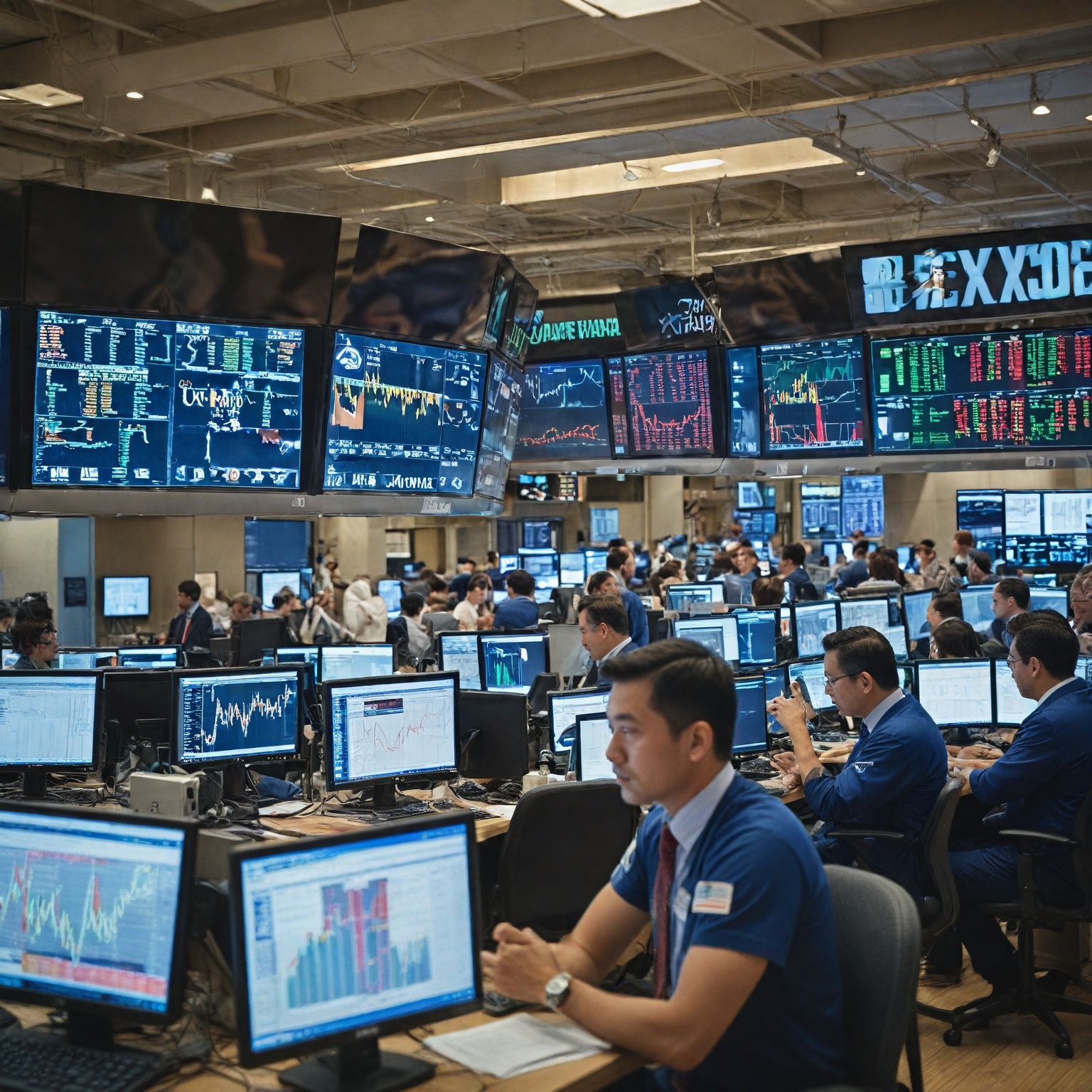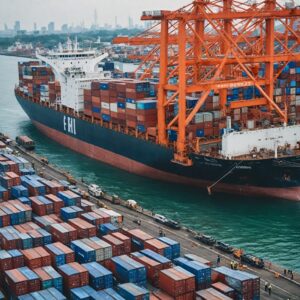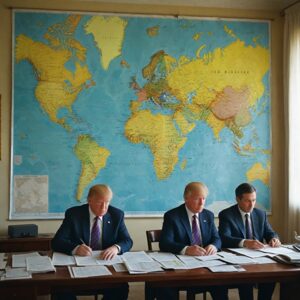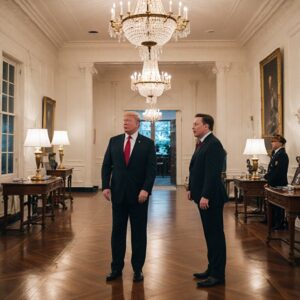Summary
The Exciting Surge in Wall Street Futures on the US-China Tariff Deal reflects a pivotal moment in the ongoing trade tensions between the world’s two largest economies. After years of escalating tariffs and retaliatory measures initiated during the Trump administration, the United States and China reached a landmark tariff agreement in 2025 aimed at easing trade hostilities and stabilizing global markets. The deal marked a significant reduction in tariff rates from previous highs—U.S. tariffs on Chinese goods fell from as much as 145% to 30%, while China lowered its duties on American imports from roughly 125% to 10% for an initial 90-day period—signaling a potential de-escalation in one of the most consequential trade disputes in recent history.
This tariff deal not only halted the trajectory of tariff increases but also spurred a surge in global market optimism, with U.S. stock futures rising sharply and Asian markets following suit. Investors responded enthusiastically to the prospects of reduced trade barriers, reflected in substantial gains in major indices and technology stocks, alongside rising commodity prices such as oil. While the agreement did not eliminate tariffs entirely, it represented a constructive step toward resolving structural issues related to intellectual property, technology transfer, and agricultural trade, continuing the dialogue initiated by the earlier Phase One agreement of 2020.
Economically, the trade war had inflicted notable damage, contributing to slowed growth, increased inflationary pressures, and the first U.S. GDP contraction since early 2022. The tariff deal’s announcement offered relief amid lingering uncertainties, though analysts cautioned that the reductions were temporary and partial, with underlying trade disputes and geopolitical tensions persisting. The agreement underscored the complex interdependence between the U.S. and China, revealing both the limits of unilateral trade measures and the challenges in achieving a comprehensive resolution.
Politically and diplomatically, the tariff deal served as a crucial signal of willingness from both sides to engage in pragmatic negotiations despite broader rivalries over technology, security, and human rights. However, critics highlighted concerns that the use of tariffs has undermined global free trade norms and the United States’ moral authority in international trade governance. Media coverage extensively chronicled the deal’s global significance, emphasizing its potential to boost economic sentiment while acknowledging that sustained progress will depend on the effective implementation of negotiated terms and continued diplomatic engagement.
Background
The U.S.-China trade war, initiated during President Donald Trump’s administration, involved a series of escalating tariffs and retaliatory measures between the world’s two largest economies. Beginning with tariffs imposed under Section 301 of the Trade Act of 1974 and the International Emergency Economic Powers Act (IEEPA), the Trump administration targeted all U.S. imports from China, leading to average tariffs on Chinese exports reaching 124.1 percent at one point. The trade conflict was driven by multiple issues, including allegations against China for forced technology transfer, subsidies to domestic tech firms, and intellectual property theft.
Efforts to ease tensions culminated in several rounds of high-stakes trade negotiations, with the U.S. and China eventually reaching a Phase One agreement in January 2020. This agreement addressed intellectual property rights, technology transfer, agricultural products, financial services, and transparency measures, among other areas, but did not utilize arbitration through intergovernmental organizations like the WTO, instead opting for a bilateral dispute resolution mechanism. Despite this progress, tariffs largely remained in place, though at moderated levels; the U.S. maintained a minimum tariff threshold of 10 percent in ongoing trade discussions, as confirmed by Commerce Secretary Howard Lutnick.
The trade war’s impact was significant, contributing to reduced trade volumes, increased uncertainty in markets, and a decline in U.S. consumer confidence. It also led to the first quarterly contraction of the U.S. gross domestic product since early 2022 and increased inflationary pressures due to higher tariffs. Experts have cautioned that complete economic decoupling between the U.S. and China is unlikely given their deep interdependence, and unilateral tariffs have been criticized for damaging the U.S.’s reputation as a proponent of free trade while ceding moral authority to China. The World Trade Organization dispute filed by China in February 2025 further underscored the ongoing friction in trade relations.
As negotiations continued, signs of a potential thaw emerged. In May 2025, U.S. and Chinese officials concluded talks on a positive note, with Treasury Secretary Scott Bessent reporting “substantial progress” and markets responding favorably to the prospects of reduced trade tensions. This development was viewed as a critical step toward de-escalating the trade war, with hopes that it would mitigate the risk of higher consumer prices and supply chain disruptions in the near future.
Details of the Tariff Deal
The tariff deal between the United States and China marked a significant development in the ongoing trade tensions that had escalated since early 2018. After intensive negotiations in Geneva, both countries agreed to a temporary easing of tariffs that had been a source of economic uncertainty and market volatility. Under the agreement, American tariffs on Chinese goods were set to decrease from as high as 145% to 30% for an initial period of 90 days, while China agreed to reduce its import duties on American goods from approximately 125% to 10%. This arrangement aimed to de-escalate the trade conflict and open the door for further dialogue.
The deal did not eliminate tariffs entirely but rather implemented a ceiling on tariff rates, with the United States maintaining a global tariff floor of 10% for ongoing negotiations with various countries, including China. Commerce Secretary Howard Lutnick confirmed that the U.S. was not willing to lower tariff rates below this 10% threshold during talks, consistent with the rates maintained in other agreements such as the one with the United Kingdom. Despite this, the agreement was described by U.S. Treasury Secretary Scott Bessent and Trade Representative Jamieson Greer as a constructive step toward addressing imbalances and national security concerns raised by the Trump administration regarding China’s trade practices.
The agreement also entailed China suspending or revoking retaliatory countermeasures that it had previously imposed, including restrictions on the export of critical rare earth metals and magnets used in various high-tech industries. Both sides agreed to suspend their respective tariff increases and continue negotiations to resolve deeper structural issues related to intellectual property rights, forced technology transfers, agricultural purchases, financial services, and currency transparency as outlined in the broader framework of the Phase One trade agreement finalized in early 2020.
Although the specific details of the agreement were initially limited, the talks were widely viewed as a meaningful step to stabilize global trade relations and reduce the risk of further economic disruption. Market analysts expressed cautious optimism, recognizing the tariff suspension as a relief that could encourage improved business sentiment and investment. However, experts also noted that the agreement was more a pause in escalating tariffs rather than a comprehensive resolution, with ongoing challenges in fully addressing reciprocal tariffs and broader trade issues expected to persist.
Market Reactions
The announcement of a trade deal between the United States and China triggered a significant surge in global market sentiment, reflected notably in the sharp rise of U.S. stock futures and major indices across Asia-Pacific markets. Following high-level meetings in Geneva, U.S. stock futures rose sharply, with Dow futures up by 1%, S&P 500 futures by 1.2%, and Nasdaq futures by 1.5% within hours of the announcement. This optimism extended to Asian markets, where major indices like Hong Kong’s Hang Seng Index gained over 2%, underscoring a broad-based investor confidence boost tied to the easing of trade tensions.
Investor sentiment was further lifted when President Donald Trump eased tensions on multiple fronts, including his relationship with Federal Reserve Chair Jerome Powell and his approach to tariffs on Chinese goods. This softer stance propelled premarket trading with the Dow soaring by 683 points, the S&P 500 rising 2.3%, and the Nasdaq-100 surging 2.8%. Technology stocks, such as Apple, Nvidia, and Tesla, experienced substantial gains, reflecting optimism about reduced trade barriers and improved market conditions. Oil prices also responded positively, with Brent crude and U.S. West Texas Intermediate futures climbing more than 2.5%, fueled by expectations that the trade deal would help stabilize global demand.
Despite these positive market movements, analysts remained cautious about the long-term implications of the deal given weeks of uncertainty caused by tariff volatility. Consumer confidence had dropped, and economic indicators showed the first quarterly GDP contraction since early 2022, partly attributed to tariffs that Goldman Sachs projected would raise inflation measures to 4% by year-end. Nevertheless, the agreement was seen as a constructive step toward reducing the $1.2 trillion U.S. global goods trade deficit and mitigating supply chain disruptions.
The costliness of establishing short positions betting on market declines was another factor limiting volatility. The unpredictability of market movements—sometimes triggered by single social media posts from President Trump causing up to 10% shifts—discouraged aggressive bearish bets, contributing to the markets’ resilience amidst ongoing trade negotiations. Market optimism remained contingent on further details of the deal being released and implemented effectively, with investors watching closely for sustained de-escalation between the two economic giants.
Economic Implications
The US-China trade war has had significant and multifaceted economic implications globally, affecting growth forecasts, market sentiment, and bilateral trade dynamics. Analysts have observed that tariff hikes and retaliatory measures between the two largest economies have slowed global economic growth, with the International Monetary Fund (IMF) lowering its 2019 global growth forecast from 3.6% to 3.3%, warning that ongoing trade tensions could further curb investment and economic activity.
J.P. Morgan Research estimated that a 10% universal tariff coupled with a 110% tariff on China could reduce global GDP by about 1%, highlighting how tariff policies can directly impact economic output. Furthermore, the IMF projected that a universal 10% rise in US tariffs, combined with retaliation from China and the euro area, could reduce US GDP by 1% and global GDP by roughly 0.5% through 2026. These economic shocks are amplified through diminished business and consumer sentiment, which in turn can magnify the adverse effects of tariffs on economic performance.
From a trade perspective, the imposition of high tariffs has disrupted established trade flows. For instance, steel exporters affected by US tariffs, including China as the largest global steel producer, have sought alternative markets, potentially increasing vulnerability in other regions such as India. This diversion of trade flows illustrates the wider ripple effects of tariff policies beyond just the US-China bilateral relationship.
Despite the immediate negative impacts, some economists suggest that in the mid- to long-term, increased tariffs may not necessarily reduce exports from China to the US. A 2023 study analyzing OECD and BRICS trade data concluded that US tariff hikes might ultimately result in increased Chinese exports to the US, possibly due to adjustments in trade strategies and market dynamics. Nevertheless, scholars like Minxin Pei have argued that the prolonged trade dispute has revealed the limitations of Xi Jinping’s ambitions for China’s rise as a global power.
Market reactions have been volatile, with tariff announcements causing initial sharp declines in stock indices like the S&P 500, followed by rebounds fueled by hopes of trade truce and progress in negotiations. Treasury officials have indicated “substantial progress” in talks, which helped lift financial markets and reduce fears of a global economic downturn. However, uncertainty remains as businesses and investors weigh the potential for further escalations or resolutions.
The trade war also affected consumer confidence and inflationary pressures in the US. Reports indicated that tariffs contributed to a contraction in GDP and forecasts of rising inflation, potentially doubling key inflation measures to 4% by the end of the year. This has raised concerns about higher costs for consumers and disruptions in supply chains, with tariffs potentially leading to increased prices and scarcity of goods in US markets.
Diplomatic and Political Significance
The US-China tariff deal marked a significant moment in the complex and often contentious bilateral relationship between the two global powers. Historically, efforts to improve diplomatic ties—such as the establishment of liaison offices following the 1972 communiqué—helped set the stage for economic engagement by temporarily setting aside contentious issues like Taiwan and opening communication channels. The recent tariff agreement can be viewed as a continuation of these longstanding efforts to stabilize and normalize economic relations despite persistent political and strategic tensions.
The deal’s diplomatic importance lies not only in its potential to de-escalate trade hostilities but also in signaling a willingness on both sides to engage in dialogue. While China remained firm that negotiations would require the lifting of US tariffs first, the mutual expression of readiness to negotiate suggested an opening for more pragmatic talks aimed at resolving broader trade disputes. US officials, including former trade representatives and economists, emphasized the positive impact of this “give and take” approach, which could pave the way for gradual tariff reductions and enhance the political viability of such agreements.
Politically, the agreement occurred amidst a backdrop of heightened rivalry characterized by disagreements over technology, military growth, and human rights, which have pushed US-China relations to their lowest point in years. Despite these challenges, both nations have expressed interest in avoiding conflict, with recent US administrations articulating a desire for “competition, not conflict,” and seeking to prevent a new Cold War dynamic. This tariff deal thus functions as a crucial mechanism for managing tensions by focusing on economic cooperation.
However, the political implications extend beyond bilateral relations. The use of unilateral tariffs by the US has drawn criticism for potentially undermining the global free trade system and the moral authority of the United States as a trade leader. China’s retaliatory measures and its disputes at the World Trade Organization reflect ongoing contestations over trade norms and regulatory treatment, highlighting the broader geopolitical stakes involved. Nonetheless, experts recognize the mutual economic interdependence of the two countries, underscoring that both have a vested interest in preserving substantial aspects of their economic relationship despite political differences.
Media Coverage and Analysis
The announcement of the US-China tariff deal prompted extensive live coverage from major news outlets, including CNBC, which reported in real time from multiple global bureaus such as Washington, London, Singapore, San Francisco, and Englewood Cliffs, New Jersey. This widespread media presence highlighted the deal’s significance and its anticipated impact on global trade dynamics. Chinese state media underscored the importance of the upcoming joint statement by Beijing and Washington, with China’s Vice Minister of Commerce, Li Chenggang, describing the release as “big news and good news for the world,” signaling optimism from the Chinese government side.
Analysts and journalists have provided in-depth commentary on the deal’s implications. Former U.S. Trade Representative Robert Lighthizer reflected on the Trump administration’s bold trade agenda, emphasizing the lasting effects these policies have had on the bilateral relationship between the United States and China, one of the world’s most complex economic partnerships. Investor sentiment also responded positively; market experts noted that signs of de-escalation between the two superpowers contributed to a rebound in equities, though cautioning that the sustainability of this optimism depends on further details of the agreement being disclosed.
The detailed contents of the “Economic and Trade Agreement between the United States of America and the People’s Republic of China,” which came into effect in February 2020, have been widely analyzed. The agreement covers various sectors such as intellectual property, technology transfer, agriculture, financial services, and exchange rate transparency, and includes bilateral evaluation and dispute resolution mechanisms distinct from traditional arbitration through international bodies like the World Trade Organization. Media coverage also touched on how this bilateral mechanism represents a new approach to handling trade disputes between the two nations.
The comprehensive reporting on the tariff deal has been enriched by journalists with diverse backgrounds covering diplomacy, global trade, and political affairs, lending depth and context to the ongoing developments. Additionally, interviews with key diplomatic figures, such as US Ambassador Eric Garcetti, have provided broader geopolitical perspectives relevant to the trade discussions and their implications for regions like the Indo-Pacific. Overall, media analysis has played a crucial role in shaping public and investor understanding of the tariff deal’s potential to boost global economic sentiment.
Aftermath and Future Outlook
The announcement of a tariff pause between the United States and China was met with widespread optimism from both market strategists and investors. Deutsche Bank strategists described the development as “better than expected,” while Kit Juckes, chief FX strategist at Societe Generale, called the tariff pause a “substantial relief” for both countries. Following the news
























